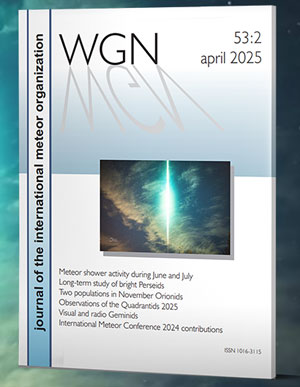The 30th International Meteor Organization Meteor Shower Calendar is available!
The main intention of the annual International Meteor Organization Meteor Shower Calendar is to draw the attention of observers to regularly returning meteor showers as well as to provide information about events which may be possible according to model calculations. This includes both the possibility of extra meteor activity in terms of additional peaks and/or enhanced rates but also the observational evidence of no rate or density enhancement. Both may help to improve our knowledge about the numerous effects and interactions between meteoroid parent objects and the streams. Further, the Calendar hopefully continues to be a useful tool to plan your meteor observing activities.
2020 Highlights
- The first quarter Moon on January 3rd creates excellent viewing conditions for the expected Quadrantid meteor shower (QUA) maximum on January 4th 08h20m UT – λ⊙ 283 . ◦15, expected ZHR = 120 (can vary ≈ 60–200). The 08h UT timing for the peak will be favourable for North America, whereas European observers should spot the activity increase all along the night. The λ⊙ = 283 . ◦15 maximum timing is based on the best-observed return of the shower ever analysed, from IMO data collected in 1992, as confirmed by radio results in most years since 1996.
- Famous Perseid meteor shower (PER) will suffer of the presence of a last quarter Moon for its maximum on August 12th 13-16h UT – λ⊙ 140 . ◦0, expected ZHR = 110, but will remain observable. Earth will potentially cross a filament on August 12, around 10h UT, with expected ZHR close to 100, just like it was predicted and it recorded in 2018.
- According to Jérémie Vaubaillon’s models, activity outbursts may be expected from the famous Draconid meteor shower (DRA) when Earth will come close to two dust trails released by in 1704 and 1711. This could leed to two activity increases on October 7, around 01h 25min UT and 01h 57min UT.
- The same could occur with the Leonid meteor shower (LEO) according to Mikiya Sato’s calculations. Earth could come close to a few dust trails released by 55P/Tempel-Tuttle in the year 1600 (giving a potential outburst on November 17, between 06h 50min UT and 08h 13min UT), in 901 (November 18, 00h 58min UT) and in 1234 (November 20, 15h 28min UT).
- Moon is new on December 14 and thus creates perfect viewing conditions for the best and reliable Geminid meteor shower (GEM) maximum on December 14 00h50m UT – λ⊙ 262 . ◦2, with an expected ZHR = 150. The timing for the peak will be favourable for European observers. Peaks ZHRs were slightly increasing over the past years and now reach up to 140-150 levels.
- The Ursid meteor shower (URS), active in December, may also be the source of a significant outburst (ZHR up to 400), according to Peter Jenniskens, when our planet will cross dust trails released by 8P/Tuttle in 829 (December 22, 06h 10min UT) and 815 (December 22, 03-22h UT ) as well as a filament to be encountered on December 22, 05h 27min UT. Less important activity increases may also happen, according to Mikiya Sato’s calculations, when dust trails released in 719/733 (December 22, 03h 15min – 03h 40min UT) and 801 (December 22, 17h 31min UT) dust trails will be crossed.
The heart of the Calendar is the IMO Working List of Visual Meteor Showers which is continuously updated so that it is the single most accurate listing available anywhere today for visual meteor observing. Nevertheless, it is a Working List which is subject to further modifications, based on the best data we had at the time the Calendar was written. Observers should always check for later changes noted in the IMO’s journal WGN or on the IMO website. Vice versa, we are always interested to receive information whenever you find any anomalies! To allow for better correlation with other meteor shower data sources, we give the complete shower designation including the codes taken from IAU’s Meteor Data Center listings.




 You saw something bright and fast? Like a huge shooting star? Report it: it may be a fireball.
You saw something bright and fast? Like a huge shooting star? Report it: it may be a fireball.  You counted meteors last night? Share your results with us!
You counted meteors last night? Share your results with us!  You took a photo of a meteor or fireball? You have a screenshot of your cam? Share it with us!
You took a photo of a meteor or fireball? You have a screenshot of your cam? Share it with us!  You caught a meteor or fireball on video? Share your video with us!
You caught a meteor or fireball on video? Share your video with us!
One comment
So many words! Information is buried.